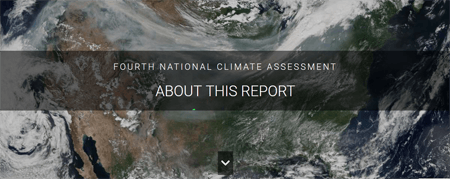RECENTLY RELEASED: Fourth National Climate Assessment Vol II
The Global Change Research Act of 1990 mandates that the U.S. Global Change Research Program (USGCRP) deliver a report to Congress and the President no less than every four years.
 The Trump administration tried to bury this 13-agency report by releasing in on Black Friday when almost no one would be paying attention.
The Trump administration tried to bury this 13-agency report by releasing in on Black Friday when almost no one would be paying attention.
The report is a big deal.
The objectives of this (1,600+ page) report are as follows: “1) integrates, evaluates, and interprets the findings of the Program…; 2) analyzes the effects of global change on the natural environment, agriculture, energy production and use, land and water resources, transportation, human health and welfare, human social systems, and biological diversity; and 3) analyzes current trends in global change, both human-induced and natural, and projects major trends for the subsequent 25 to 100 years.”
More background: NCA4 Vol II, Impacts, Risks, and Adaptation in the United States, assesses a range of potential climate change-related impacts, with an aim to help decision makers better identify risks that could be avoided or reduced. The assessment follows Vol I, the Climate Science Special Report (CSSR), which was released in November 2017. Together, these reports meet the requirements of the Global Change Research Act, which mandates a quadrennial assessment of our understanding of global change and its impacts on the United States.
As the country’s third most vulnerable region to the effects of sea level rise, the Eastern Shore can become a national model for coastal resilience in rural communities. ESLC works to understand and communicate the risks associated with sea level rise. We build resilience through community-oriented projects and by connecting local governments with resources and assistance to prepare for future coastal flooding and storms. Learn more about these risks and our ongoing efforts to mitigate them by subscribing to our biweekly newsletter, Resilience Matters.






